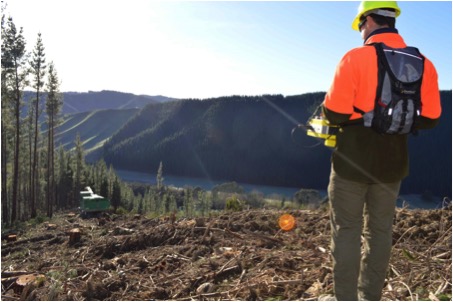
WorkSafe New Zealand says many of the woodlots on farmland were planted on steep ground which made harvesting these trees highly dangerous. Source: Stuff NZ
Woodlots can be dangerous territory for farmers who are better to bring in the professionals when they want them harvested safely.
Many of the woodlots were planted 25-40 years ago and are due to be harvested. They were often planted on steep hill country that required skillful and experienced operators to harvest them, WorkSafe chief executive Nicole Rosie said.
Speaking at Fieldays, Ms Rosie said the Ministry for Primary Industries had forecasted an additional 35 million cubic metres of wood would become available for harvest between 2015-2025 from today’s production of 28 million cubic metres.
“It’s quite a substantial increase and a lot of that is small scale forests planted in the 1990s.”
Many of the trees were planted on steep country, which made harvesting dangerous and expensive. There had been a 44% fall in severe injuries and a 30% reduction in moderate injuries within the forestry sector in the past few years.
That was driven largely by the professional forestry companies who are better managing workplace risks, she said.
The forestry sector was highly concerned because a lot of these woodlots were small, but posed a high risk.
“The risks of those logs because they are steep, because they are on difficult terrain and they are small that people could use inexperienced loggers or revert to techniques that are highest risk techniques.”
Instead, farmers should use an industrial-scale harvest operation because it was safer as operators had automated higher risk activities.
Ms Rosie said it was not worth the risk for farmers to harvest the trees themselves.
“You might think it’s a cost effective option – it’s not. The incidence of death and injury are really high historically in the types of operations these guys are doing which is steep operations and manual felling – that is the highest risk operation from a forestry perspective.”
Harvesting woodlots required having a management plan, safe access for people cutting trees and using experienced harvesters in high-risk operations.
Landowners could also be in breach of the new health and safety legislation if they chose to harvest the trees themselves, she said.
“There are processes that have to be followed to register a cutting and as part of that registration, they come onto the radar as potentially a high risk operation.”
Manual felling was the highest risk operation in forestry and automated harvesting has been the single biggest thing that has reduced that risk.
The new health and safety legislation had now been in place for over a year.
Ms Rosie said surveys showed an increasing number of farmers were involved in work safe activities and were finding interactions with health and safety regulators a positive experience.
“There has definitely been a very positive uptake of health and safety messaging, The industry itself has taken a lot of leadership around that messaging.”
That suggested that farmer attitudes were changing, Ms Rosie said. There were 10 farmers prosecuted for breaching health and safety laws in 2014, eight in 2015 and six last year.
“You are far more likely to die than to be prosecuted by WorkSafe.”
Data over the past three years showed that farm employees were also more likely to be injured on the farm than self employed farmers.
For every 1000 people employed in the agricultural sector, 20 received an injury requiring more than a week off work. For self-employed, it’s 12.
There were 18 reported fatalities on farms last year and seven so far this year.





